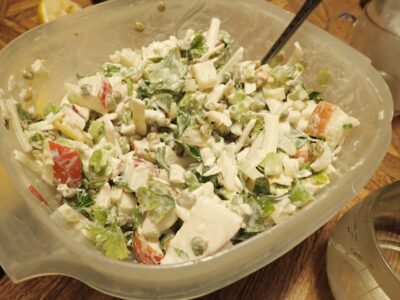Kohlrabi, the ‘turnip-cabbage’

(Provided photo — Yvona Fast)
I bought some kohlrabi last Saturday at our farmers’ market. I was surprised to find kohlrabi this early in the season — but this hardy vegetable can be left in the ground when frost hits and harvested in the spring.
I’m acquainted with kohlrabi from my European roots, but many Americans are unfamiliar with it. “Call-what?” they ask, and they’re not alone.
This cruciferous veggie has a strange-sounding name and a shape resembling a miniature parachute or hot air balloon. It’s popular in France, Germany and other northern and central European countries. It was known in Ancient Rome and was mentioned by Pliny the Elder and Apicius, the oldest known cookbook author, who used it in his recipes. Charlemagne was so fond of kohlrabi that he ordered it grown in the Holy Roman Empire, which may account for its popularity to this day in Germany and France. The word comes to us from German: Kohl meaning cabbage and Rabi meaning turnip. That is why it is often known as the “turnip cabbage.” Like other members of the cabbage family, it is fairly winter-hardy and can be left in the ground after frost hits. This accounts for its popularity in northern European countries and makes it a good vegetable for North Country gardeners.
Like other cruciferous veggies, kohlrabi has many health benefits. With just 19 calories in a half-cup serving, it is an excellent source of fiber, potassium, calcium, vitamins A and C and folic acid. The greens are a good source of iron. According to Dr. Joseph Mercola and Larry L. Frieders, R.Ph., kohlrabi helps to stabilize blood sugar, so it’s good for diabetics and hypoglycemics. It is also purported to help with viral conditions, candida and edema.
Often mistaken for a root vegetable, kohlrabi is not a root at all. The round bulb grows above ground, as part of the stem. They come in both pale green and purple colors, though once peeled, the inside is ivory white with the palest hint of green. The leaves and stems can be added to leafy salads or cooked like spinach. The skin and root tip can be tough, so I peel and discard them.
When shopping, look for bulbs no bigger than two to three inches in diameter (the larger ones are tough and woody) with fresh, bright greens attached. Avoid bulbs with cracks. Yellowed greens indicate that it’s not fresh. Store in the vegetable crisper of your refrigerator. They will keep for a while, but will become tougher and stringier if stored too long.
To use, peel the kohlrabi. Trim off the tough root end and the stems. The greens can be chopped and added to a tossed salad or added to soup. Cut or grate, depending on the recipe.
Young, tender kohlrabi makes a great salad or slaw. Porous, crisp, juicy and succulent, it absorbs the flavors of dressings and sauces. It can be cut into julienne strips and eaten raw with dip on a vegetable tray. My favorite way to eat is simply to peel and bite into it, like an apple.
It can also be steamed, boiled, baked or fried. Cut into bite-sized pieces, add just a little water and a dash of salt, and simmer for 5 to 7 minutes — just a minute or two for the leaves and stems, as you would spinach. Try adding to stir-fries, cooking for just five minutes or so, with a bit of garlic or onion. To cook on the grill, toss chunks with olive oil and salt, wrap in foil and cook about 10 minutes. Try it sliced into rings along with carrots, sprinkled with a little fresh parsley and baked au gratin. Or cook and mash along with potatoes for a subtly different flavor.
–
Kohlrabi, potatoes and carrots
–
This elegant side dish goes well with fish or chicken and is my favorite way to cook kohlrabi.
Ingredients:
2/3 cup vegetable broth or water
1/2 teaspoon salt (if using water)
1 kohlrabi
1 carrot
1 potato
1/4 cup fresh minced parsley
1 tablespoon butter
Directions:
Peel and dice the kohlrabi. Bring broth to boil, add kohlrabi, lower heat, and cook about 5 minutes. In the meantime, dice the carrot; add. Then peel or scrub and dice the potato, and add. Keep an eye on the amount of liquid; if it goes dry, add a little more water or broth. When vegetables are tender, test for seasoning; add additional salt and pepper, if needed. Stir in parsley and butter. Serve warm.
Option: Cook 1/2 pound of chicken tenders and stir into the dish.
–
Kohlrabi Carrot Salad
–
Ingredients:
1 medium kohlrabi — about 1 cup, shredded
1 medium carrot — about 1 cup, shredded
1 cup arugula greens
1/2 teaspoon salt
2 teaspoons olive oil
2 teaspoons fresh squeezed lemon juice
Directions:
Peel kohlrabi; shred. Wash carrot and shred. Stir in arugula greens. Sprinkle with salt and toss to combine. Add olive oil, and toss again; then lemon juice, and toss. Serve chilled or at room temperature.
——
Author of the award-winning cookbook Garden Gourmet: Fresh & Fabulous Meals from your Garden, CSA or Farmers’ Market, Yvona Fast lives in Lake Clear and has two passions: writing and cooking. She can be found at www.yvonafast.com and reached at yvonawrite @yvonawrites.


